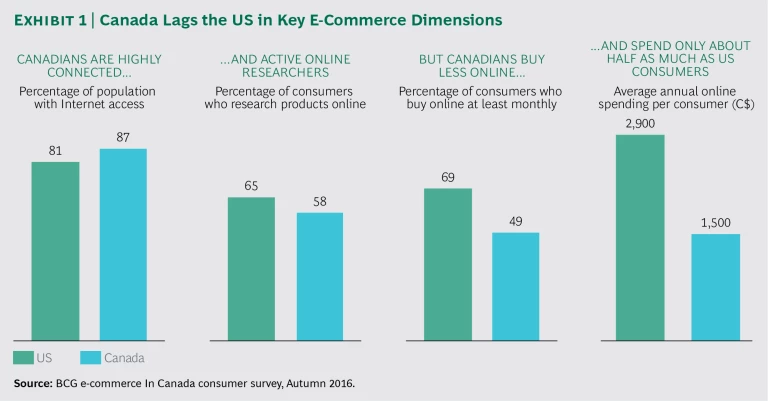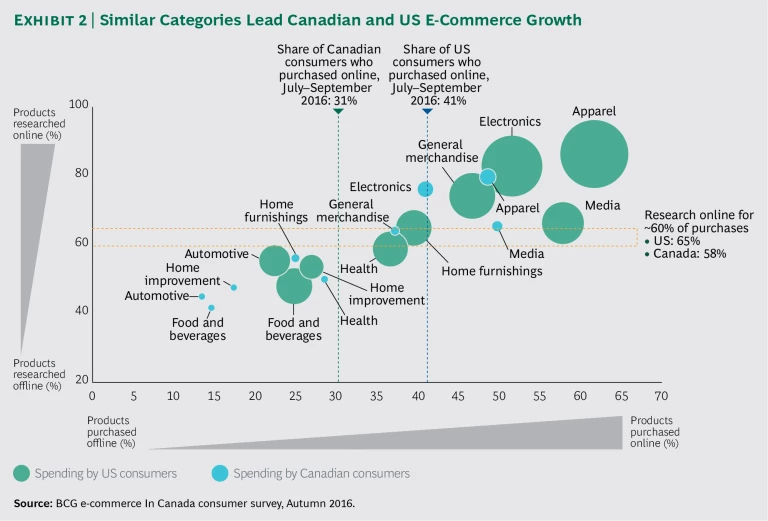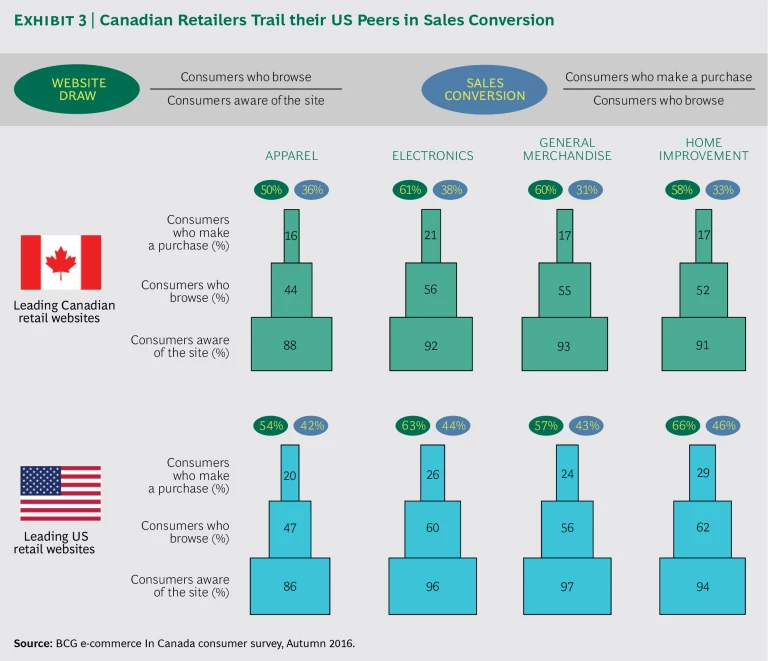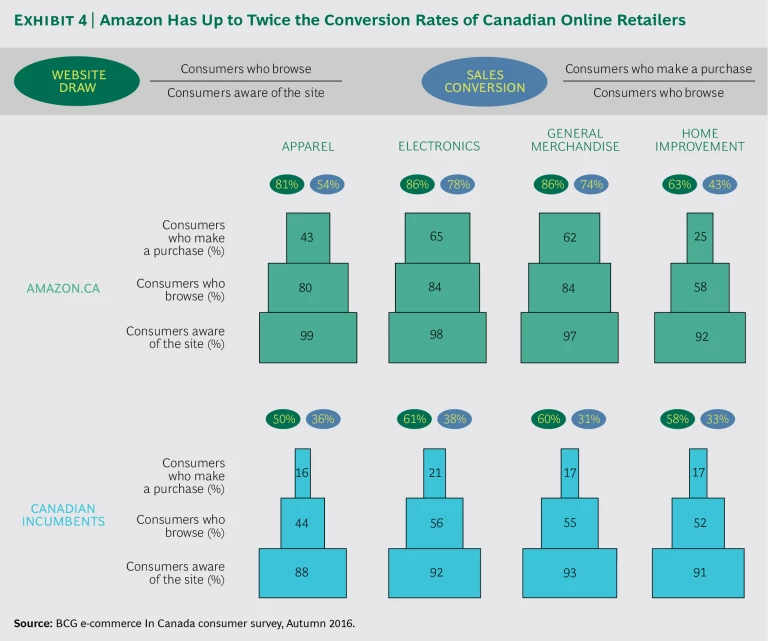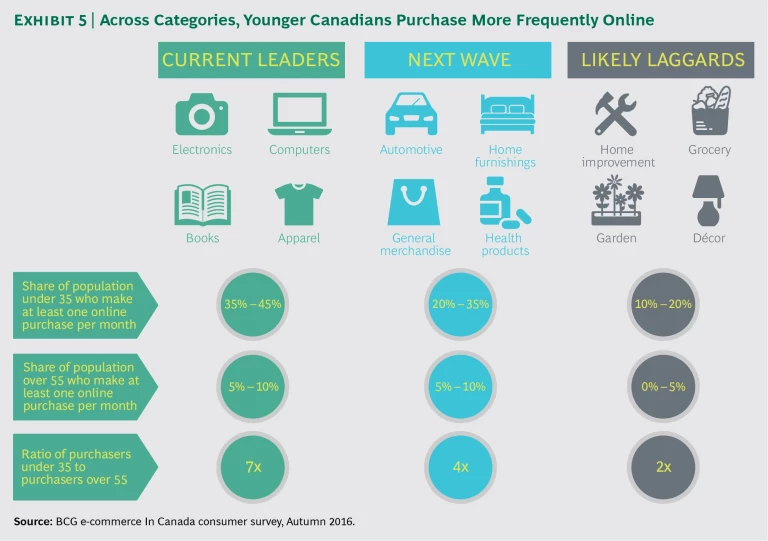It’s been a long time coming, but the digital disruption of Canada’s retail market is finally gathering steam. The question is, are Canada’s retailers ready to take their share of e-commerce sales, or will they cede share (and, in the process, growth) to Amazon and other big US online players? Billions of dollars of shareholder value are at stake, and right now, the home team is behind the digital curve.
The e-commerce market in Canada trails that of other advanced countries, such as the US and the UK, but it has been picking up speed for the last five years. Annual Canadian e-commerce consumer revenues are now estimated at more than $20 billion, or about 7% of the nation’s $352 billion in total retail spending in 2016. (By comparison, e-commerce makes up more than 10% and 15% of retail spending in the US and UK, respectively.)
We expect online channels to deliver more than 35% of all Canadian retail sales growth in the coming decade, as consumers dramatically increase their e-commerce activity. Spending dynamics will vary considerably by category (with digital channels responsible for all the consumption growth in some categories), but it is clear across the board that if retailers do not move aggressively for online and mobile sales, they will face stagnant and even falling revenues and a loss of consumer relevance.
Drawing on a recent BCG study of Canadian consumers and their e-commerce behaviors, this report examines the opportunities and threats for Canadian retailers in this fast-changing market and what they need to do to position themselves to win as more business moves online.
The Opportunity: Fast-Rising E-Commerce Demand
Digital commerce has been slow to develop in Canada, despite the fact that the country is a global leader in digital activity generally, with over 80% of the population connected and regularly online (on a par with the US, for example). Accounting for 7% of overall retail sales, e-commerce in Canada stands where the US was in about 2011, owing to both less frequent online purchasing and smaller basket sizes. While almost 70% of US consumers make purchases online at least once a month, the comparable figure in Canada is only about 50%. US consumers also spend almost twice as much online—the equivalent of almost C$3,000 a year compared with Canadian average spending per consumer of only C$1,500 a year. (See Exhibit 1.)
That said, several categories are now seeing rapid growth in e-commerce, in part because retailers are raising their game by importing successful e-commerce business practices from abroad, addressing basic barriers to online sales such as shipping costs, returns, and digital payments, and improving the overall “e-tail” experience. A number of new e-tailers are entering high-growth categories (such Wayfair and Endy in home furnishings).
We believe that the gap with the US and other nations is about to close as changing consumer behaviors and demographic shifts support a dramatic acceleration of Canadian e-commerce in the decade to come. We see four key reasons for this growth.
Younger Canadians are spending more online. Our research found that younger Canadians (18 to 44 years old) are two to four times more likely than older consumers (over 55) to make at least one online purchase a month. Moreover, the younger the buyer, the more active he or she is online: in early-mover categories such as electronics and general merchandise, about 50% of Canadians under 35 make online purchases at least once a month. Purchasing by top-quartile spenders under 35 is similar to that of young US consumers; average annual online spending tops C$4,000 for both groups. As younger Canadians age and make up a larger portion of the retail market, these behaviors are expected to drive greater demand for online offerings in many categories.
Consumers of all ages are engaging in online research. The history of markets with extensive e-commerce activity shows that consumers’ use of digital channels for research is a key precursor to increased levels of online spending. Today, Canadian consumers do some form of online research in advance of nearly 60% of all purchases—about the same level as US consumers. The most common research activities are searching for information on products, comparing prices, reading reviews, and seeking nearby retailers.
Online research and purchase trends by category in Canada are following similar trajectories to those in the US and point to the categories that can be expected to lead Canadian e-commerce growth. (See Exhibit 2.) These include such typical e-commerce early movers as electronics (computers, TVs, and audio accessories), media (videos, music, and digital content), and apparel (shoes, accessories, and some types of clothing). The level of research activity in Canada suggests that both general merchandise and home furnishings will also be key growth categories for e-commerce in the coming decade, as researchers are converted into buyers. In apparel, we expect that growth may come more from larger online basket sizes and more frequent purchases than from significant increases in the number of online shoppers.
Canadian retailers’ online draw is reaching US levels. Leading Canadian retailers are generating similar levels of website draw (the share of consumers who are aware of a website and also browse products on that site) as their US counterparts: 50% to 60% of Canadian consumers aware of a website typically spend time there. These same Canadian websites consistently lag US players in conversion. (See Exhibit 3.) And even among consumers who do purchase, overall basket sizes are smaller than those of US consumers, with Canadians buying fewer, smaller-ticket items.
The online assortment gap is closing. Many Canadian consumers have experienced the frustration of browsing a website only to find that the company doesn’t ship to Canada and Canadian retailers don’t offer the item desired. As e-commerce took off south of the border, Canada’s online assortment lagged, and even today, the US websites of retailers doing business in both countries have product assortments up to ten times greater in some categories than their Canadian sites.
Product availability is improving, however, particularly as leaders move online. Significant investments by Amazon, Walmart, and others are rapidly expanding online offerings in Canada. Amazon’s assortment in Canada increased 200% between 2013 and 2016, for example, and Walmart now lists tens of thousands of items on its Canadian website. The company also invested more than C$100 million in e-commerce in Canada in 2015, adding two e-commerce distribution centers, and it has begun offering online grocery delivery in the greater Toronto area.
This increase in product availability will drive Canadians to buy more online in two ways. First, current online shoppers will purchase more often. Today, only 30% of Canadian consumers buy online in more than two categories a year, compared with 55% of US consumers. Second, new users will be lured to the online channel. In 2016, only 60% of Canadian consumers made a purchase online, versus 85% of US consumers. And Amazon.ca and Walmart.ca are among the biggest Canadian online players.
For all these reasons, we expect online spending to follow in the footsteps of the US market, sooner rather than later. This raises three fundamental questions for Canadian retailers. Which categories will move first and furthest? Who will be best positioned to take advantage of this growth? And who will be left behind?
Can Canadian Retailers Meet the Demand (Before Others Do)?
Canadian e-commerce capabilities lag those of the US, one reason why Canadian consumers send more a third of their online spending south of the border, despite currency issues, import duties, and shipping costs. In some categories, Canadians report that as much as 60% of their online spending is done on US websites. Selection also plays a big role: even as product availability on Canadian sites improves, estimates suggest that Amazon.ca has less than 50% of the assortment of Amazon.com, and Walmart.ca has less than 20% of the assortment of Walmart.com.
There are several reasons for the lag. A number of strong domestic brands with highly productive retail stores have been hesitant to move aggressively online for fear of shrinking their brick-and-mortar operations. No broadly successful Canadian “digital native” startup has achieved substantial scale, threatening brick-and-mortar incumbents as happened with Amazon in the US, Rakuten in Japan, Alibaba in China, and Otto.de in Germany. Indeed, some companies that recently made forays into Canadian e-commerce, such as Shop.ca and Beyond the Rack, wound up filing for creditor protection.
Scale plays a role as well. The major US players have used their size and resources to establish a strong presence in Canadian e-commerce. The top e-tailers by Canadian consumer spending are all from the US (Amazon, e-Bay, Apple, Walmart, Costco, and Home Depot) and make up almost half of Canada’s e-commerce market. Recent publicly available data further suggests that the e-commerce sites of multiple US players (such as Nike, Foot Locker, Urban Outfitters, Home Depot, Amazon.ca and .com, Costco, and Walmart) have seen the biggest year-over-year increases yet in online visits from Canadian buyers. This represents a significant lost opportunity for incumbent domestic retailers.
Canadian incumbents also lag their US counterparts on almost all the critical dimensions of e-commerce activity: site draw and traffic levels, sales conversion, product assortment, and customer retention. Addressing these gaps is critical to building competitive and relevant online offerings.
The 800-Pound E-Commerce Grizzly
Time is of the essence. The US experience shows that when deep-pocketed disruptors make significant inroads with new models that consumers like and quickly grow accustomed to, they are difficult to dislodge. (See Digital Insurgents, Emerging Models, and the Disruption of CPG and Retail , BCG Focus, March 2017.) Amazon—the biggest US disruptor of all—is already a significant force in Canada and poses a material risk to incumbents across all core categories. The company has invested heavily over the last five years, setting up its first Canadian distribution center in 2011 and adding five more facilities since then. Its distribution network has grown six times to more than 3 million square feet as of 2016. Amazon has more than doubled its product assortment across all categories, with a special focus on electronics and home and kitchen.
The number of unique monthly visitors to the Amazon.ca website soared 65% from 2013 to 2016. Today, half of Canadian consumers visit Amazon.ca at least once a month. In multiple categories, more than 80% of Canadians report regularly browsing Amazon.ca—compared with only about 55% who regularly browse traditional retailers’ websites. Amazon customers are also far more likely to end up making a purchase than visitors to other sites. (See Exhibit 4.)
Amazon Prime presents a further threat. Prime has gained massive penetration in the US in only a few short years; almost half of all US households are members, paying an annual fee of $99. Prime members are also any company’s dream customers. They spend two to five times more online than non-Prime members, and they are typically very loyal, devoting over 50% of their online spending to Amazon. Although Prime offerings currently lag in Canada compared with the US, they are catching up quickly. In September 2016, Amazon.ca launched same-day delivery in Toronto and Vancouver for Prime customers, and it now offers its original video content to Prime subscribers.
Despite its deepening penetration of Canadian e-commerce, Amazon.ca still lags its US counterpart in terms of the percentage of shoppers who browse and purchase on the site, so it has significant room to grow. It is essential for incumbents to capture market share with non-Prime members before they become Amazon loyalists and become even more challenging to win back.
The Need to Act Now
Canadian retailers face a conundrum. It is no exaggeration to say that billions of dollars will likely be lost by companies that take a cautious or an incremental approach, trying to “play at digital” without making the full commitment necessary to win. Yet at the same time, companies are understandably hesitant to move too quickly, as the investment can be significant and the near-term economics are often unattractive.
The risks of inaction, though, are equally troubling. For example, a shift of 5% of retail sales to online channels (an amount that would bring Canada up to US penetration levels) could result in a sales decline equal to C$20 to C$30 per square foot for retailers that remain exclusively in the brick-and-mortar channel (naturally, this varies significantly by segment and type of store). While we expect the speed and depth of disruption to differ by category, retailers have no real choice but to make big bets to ensure their relevance and survival.
Canadian retailers can take lessons from their US counterparts, both the ones that were slow to react to digital incursions and are now bankrupt (see Circuit City, Sports Authority, RadioShack, and Eastern Mountain Sports, among others) and those that are fighting back aggressively, scaling up their own e-commerce offerings and thinking through how they can use their existing assets—such as their stores, their customer relationships, and their customer data—to fend off insurgents.
We are not advocating simply throwing money at the problem. Bets have to be both at scale and focused, especially since time is not on incumbents’ side. As e-commerce picks up speed in Canada, digital giants such as Amazon and Walmart are moving into more categories, and unless Canadian retailers act quickly to protect their home turf, a self-reinforcing cycle will develop. Insurgent retailers will become the first choice for more consumers on more occasions, which, in turn, will enable them to build tighter customer relationships that generate more and better data. Leaders will then be able to use this data to more effectively (and intrusively) anticipate and meet consumers’ needs. Innovations such as Amazon Prime, regular replenishment of consumer staples, and click-and-collect online shopping and in-store pickup models are continuing to gain traction and peel away customers from incumbents.
Play for the Endgame
Smart retailers will focus on the endgame: a marketplace in which consumers have turned to digital channels in most, if not all, categories. In this world, retailers will compete for customer relationships more than for individual purchases. And they will compete with a mix of players: well-established digital insurgents, companies that have used their brick-and-mortar assets as the basis for new physical–virtual retail models, and companies that have come up with altogether new, predominantly digital models.
The speed and extent of e-ecommerce’s impact will vary by category. The most highly penetrated categories so far are ones in which prices can be easily compared and are high relative to shipping costs. These categories are also popular with younger shoppers, who tend to be more digitally savvy. In electronics, books, and apparel, for example, young Canadians (those under 35) purchase online seven times more frequently, on average, than consumers over 55. A similar dynamic is emerging in the next wave of categories to experience serious digital disruption, including automotive, home furnishings, general merchandise, and health products. (See Exhibit 5.) Young Canadians are also purchasing more frequently than their parents in these categories, but the behavior is not yet firmly entrenched.
The challenge for Canadian retailers—regardless of category—is to determine how to make use of their core strengths in order to become the first choice for new consumers on multiple occasions of product discovery and purchase (and thereby become a more regular part of their daily lives) while maintaining profitability. This is a complex task, and it has multiple moving parts. Online retailers need to build a strong presence that includes broad product assortments, strong content support, competitive pricing, and frictionless ordering. And they will need to offer multiple fulfillment options that work for consumers and are also financially viable for retailers, regardless of time of day (such as when stores are closed), distance, and method of transfer (such as click-and-collect, storage lockers, and home delivery). It’s a tall order in a country as large and with such a widely dispersed population
as Canada.
Here are three areas that every retailer must think through.
Stores and Cost Structure. Digital economics often turn big stores from consumer destinations into company liabilities. A department store or big-box discount center can house several thousand SKUs, but the average family buys only a fraction of them each year. When that family—or a significant percentage of younger consumers—starts ordering its most commonly purchased SKUs online, the economics of large stores suffer. At the same time, consumers do value physical stores, especially in categories where touch, feel, and freshness are important. Even Amazon has begun experimenting with brick-and-mortar outlets in the US (although, typically, it is also trying out new models, such as no-checkout shopping, at the same time).
Stores aren’t going away, but their function will evolve in multiple directions, especially in the more highly penetrated e-commerce categories. In the future, for example, stores may serve more as showrooms, pickup points, or packing centers than as shopping destinations. Bonobos, a US retailer of men’s clothing, illustrates one scenario. Originally online only, it has now opened more than two dozen “guideshop” retail locations, where customers can try on clothes and place orders; purchases are then shipped to them from a single distribution center.
Retailers need to adjust their footprint and cost base for this kind of new marketplace, a process that is already underway in more advanced digital markets. Leading retailers are finding creative ways to take advantage of their physical sites, using them for product trials, in-store advice, and rapid exchanges. They are also turning stores into click-and-collect centers and ship-from-store facilities. In the US, Walmart, Old Navy, and Target, among others, are experimenting with smaller store formats, as are major retailers in Europe. There are 900 click-and-collect sites in France; in the UK, Sainsbury’s operates 800 click-and-collect centers and Tesco almost 700.
Assortment, Pricing, and Fulfillment. For similar reasons, retailers need to rethink the assortment they offer both online and at the store on the basis of distribution economics and how people buy. Distribution economics suggest that retailers will want to segment their offering, with lower-priced, high-turn items sold primarily in the store and higher-priced, low-turn goods sold online. Companies may shrink the size of their stores and at the same time cost effectively expand their online assortment and emphasize exclusive products and their own brands to differentiate themselves and defend against price-based online competition. Sporting goods retailer Decathlon, which originally sold third-party branded products through its brick-and-mortar network, now sells both online and in-store throughout Europe and Asia and generates more than half its €10 billion in annual revenue from its own brands.
As retailers gain an understanding of who their customers are and how and what they buy, they can design individualized offers and pricing-per-customer models, such as loyalty-based subscribe-and-save programs. Online fashion retailer Stitch Fix asks shoppers to fill out a personal profile, on the basis of which it sends them five individually chosen items that the customer can keep or return as desired. According to the company, “No two clients have ever received the same selection of items.” This model is also being experimented with in Canada, led by companies such as Frank + Oak and Five Four Club, among others.
For any e-commerce operation, getting the customer’s order into her or his hands is the trickiest, as well as the most expensive and scale-dependent, part of the equation. In Canada, the country’s size and large swaths of sparsely populated territory exacerbate the difficulty. A key challenge for all retailers is how to provide the range of fulfillment options consumers want (home delivery, in-store collection, third-party delivery, and storage lockers, to name a few), while managing the economics of all of them, which can vary widely. The oft-mentioned barrier of high shipping costs is a challenge in Canada, but only in rural regions, as more than 80% of Canadians live in relatively densely populated areas. The more significant dilemma facing retailers is developing cost-effective differentiated fulfillment models that satisfy both urban and rural consumers and managing the thorny issue of charging customers different prices depending on their location.
Customer Focus. Innovative retail companies are disrupting the market by putting customer satisfaction, savings, and convenience at the center of their business models. Think Amazon Prime (“free” shipping), Amazon Subscribe and Save (effort-free replenishment), Dollar Shave Club (everyday supplies arrive as you need them—at lower cost), and Boxed (bulk quantities for those without easy access to warehouse stores). Traditional retailers have no choice but to follow suit and shift their focus from category economics to customer economics—that is, the lifetime or annual value of the customer rather than the value of an item or a shopping basket.
In the US and Europe, digital channels and advanced marketing techniques, such as digital targeting and data analytics, are reshaping the purchase pathway for consumer-facing companies in all industries, from travel and hospitality to consumer products and retail to financial services. Advanced marketers are using technology and data to actively shape consumers’ cross-channel experience of their brands and products.
To build in-depth customer profiles and the personalized relationships that will be increasingly important to securing customer ownership, Canadian retailers will have to invest in both technology and people. Especially important is developing or acquiring the technical skills necessary to capture and manage a company’s own data and combine it with data from external sources. This kind of complete digital capability is one that can provide an understanding of the evolving customer purchasing pathway and the roles of marketing, merchandizing, and supply chains in the digital economy. Structuring and integrating such a digital team into an existing business can be an especially tough challenge, given the need for collaboration and the risk of conflict across channels. Many retailers are finding it effective to establish separate teams that are measured against shared objectives and coordinated in a way that encourages interaction.
Be Bold—and Focused
Two watchwords should govern retailers’ decision making as they navigate the transition to an omnichannel marketplace: boldness and focus. The reason for boldness is simple, even if execution is hard: the road to ruin to paved with incremental decisions. This is what makes focus important: companies need to play to their strengths. Rather than try to be everything (or even many things) to most consumers, retailers should determine the key driver of consumer choice (such as speed, flexibility, value, breadth of assortment, or in-store advice) that they can own. The driver has to be an important consideration for consumers in the retailer’s categories, and the company should already have an advantage that it can build on. Retailers must establish a seamless customer experience across both the online and in-store channels around this driver. They should reorient both the space of their stores and the shape of their networks according to the new economics of e-commerce. And they should set up a distribution model that is cost- or speed-advantaged to support their identified advantage, recognizing that a national one-size-fits-all approach is unlikely given Canada’s challenging geography. Tough choices about territory or multiple models may be necessary.
The threat to Canadian retailers from Amazon and others is real and immediate. Because of the slow development of e-commerce in Canada, local companies lag industry leaders in multiple critical areas, including online traffic, sales conversion, product assortment, and loyalty and retention. Even more important, they trail in developing crucial capabilities that help shape the customer experience and purchase journey. As e-commerce takes off in Canada, incumbent players need to invest now to catch up and secure market share—or risk being locked out of their own market as Canadian consumers establish their online buying habits.
Acknowledgments
The authors are grateful to Kartik Kamat, Zane van de Put, and Kyle Trahair, without whose assistance this report would not have been possible.
